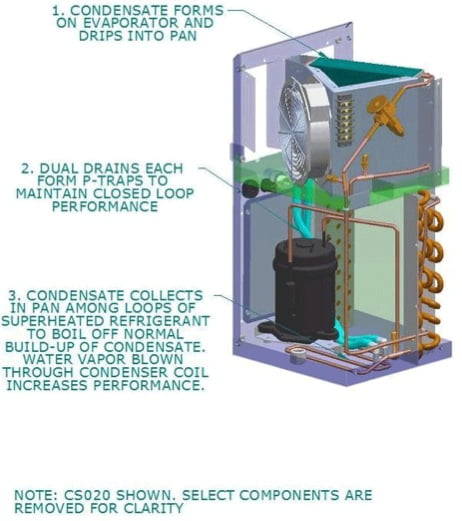Better Condensation Management for Electrical Enclosures: Why You Need It

Condensation forms naturally when the internal temperature inside an electrical enclosure reaches the dew point and which, if not dealt with, may cause many problems. These issues include the possibility of corrosion, equipment damage, and the risk of electric shock. Also, in electrical enclosures fitted with enclosure air conditioners, water collects on the evaporator coils and has to be removed. Many vendors fit condensate drains to their enclosures to remove condensation, but this often creates other problems. It is better to implement proper condensate management techniques to deal with condensation and avoid custom-made drainage systems.
Causes of Condensate
Air always contains moisture and the amount it contains is indicated by its relative humidity. Relative humidity is dependent upon temperature. As air heats up, its relative humidity drops, and as it cools, the relative humidity increases until reaching 100 percent where water condenses out of the air. The temperature at which this occurs is known as the dew point.
In high humidity coastal climates the dew point can be as high as 80 ºF, so in such climatic conditions, condensation inside an electrical panel is inevitable. The usual method of condensate removal is to fit a condensate drain. However, this often creates several other problems.
Here are four reasons why better condensate management is required:
1. Water Collection Inside Enclosure
Even when condensate drains are fitted, if the temperature of an electrical enclosure and its components falls below the dew point, water condenses on these components and the panel. This may cause corrosion that can result in the seizure of moving parts and failure of electrical and electronic components. Additionally, the enclosure may start to corrode where water collects.
2. Blocked Drains
Condensate drains have a tendency to clog, especially if the discharge pipes run along flat surfaces. During the dry season when there is little condensation, dust, dirt and foreign matter may collect in the pipe and cause blockages. A blocked drain produces an accumulation of water in the enclosure and air conditioner drain pan, resulting in numerous problems.
3. Water Dripping Onto Floor
Unless a drain is nearby, the condensate drain pipe usually discharges onto the floor near the panel. While this may not be a major issue in a dry climate, in a humid climate the volume of water is unsightly, creates a risk of employees slipping, and is potentially hazardous to staff who work near the enclosure.
4. Risk of Electrical Shock
Condensate presents a serious risk of electrical shock. This is especially relevant on systems running at 480 volts and 240 volts, but even at 120 volts an electric shock in damp conditions could be fatal.
To ensure the safety of personnel who have to work near electrical enclosures, it’s important that no water collects or condenses on the panel surfaces and equipment where it could come into contact with staff testing circuits and working on live equipment. Panels that operate in high humidity should always have an effective condensate removal system.
Condensate Evaporation Is a Better Solution
For condensation that forms in an electrical enclosure at lower temperatures, a heater can be used to keep the temperature in the enclosure above the dew point. The heater can be mounted inside the enclosure or provided as an option inside an enclosure air conditioner.
The most effective method of dealing with condensate that can form at higher temperatures is the use of an enclosure air conditioner. This will remove the moisture from the air while cooling it because the moisture condenses on the evaporator coil. Instead of draining this water away, a condensate evaporation system that that uses the hot refrigerant tubing to boil off the condensate also lowers the amount of work the compressor has to do, resulting in a significant reduction of energy usage.
Thermal Edge’s innovative condensate evaporation solution is standard across our entire enclosure air conditioner range. If you’re experiencing difficulties with condensation in your electrical enclosure, contact our sales team; they will gladly demonstrate the best method to manage condensate in your electrical enclosures.

